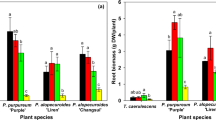Abstract
The uptake of cadmium (Cd) by capeweed (Arctotheca calendula), subterranean clover (Trifolium subterraneum), santiago medic (Medicago santiago), wimmera ryegrass (Lolium rigidum) and kikuyu grass (Pennisetum clandestinum) was measured over an eight week period following seedling emergence from a loamy sand amended with nine concentrations of Cd (0–50µg g−1). The uptake of Cd from soil amended with either 0 or 1µg Cd g−1 was also measured at 7 day intervals over the eight week growing period.
With the exception of wimmera ryegrass, yields were reduced by addition of Cd, and this reduction could be described by simple linear or quadratic equations. Addition of Cd increased the concentration of Cd in plants and the increase could be described using a rescaled Mitscherlich function. However, the accumulation of Cd at high levels of addition was depressed due to the effect of Cd supply on yield and a modified function was used to describe this effect.
The concentration of Cd in tops (µg g−1) did not vary markedly with plant age. For Cd additions corresponding to typical levels of plant-available Cd in Western Australian (WA) pasture soils, the concentration of Cd in tops harvested six or eight weeks after emergence was about four times greater in capeweed than in subterranean clover or kikuyu, and about eight times greater than in wimmera ryegrass or santiago medic. However, because of differences in the moisture content of tops, there was only a threefold difference in the potential contribution to the Cd burden of grazing sheep between capeweed or subterranean clover at typical levels of soil Cd. For most plants, Cd concentrations in roots were about ten times greater than in tops, except in capeweed which translocated more of the Cd taken up to tops. A reduction in the Cd burden of grazing animals in WA would most likely be achieved by the production of pastures that are low in capeweed and dominated by species which can survive the drier periods of the grazing season.
Similar content being viewed by others
References
Barrow NJ (1975) The response to phosphate of two annual pasture species. II. The specific rate of uptake of phosphate, its distribution and use for growth. Aust J Agric Res 26: 145–156
Barrow NJ and Mendoza RE (1990) Equations for describing sigmoid yield responses and their application to some phosphate responses by lupins and by subterranean clover. Fert Res 22: 181–188
Barrow NJ Gerth J and Brümmer GW (1989) Reaction kinetics of the adsorption and desorption of nickel, zinc and cadmium by goethite. II. Modelling the extent and rate of reaction. J Soil Sci 40: 437–450
Bramley RGV (1990) Cadmium accumulation in New Zealand agriculture. NZ J Agric Res 33: 505–519
Bramley RGV and Barrow NJ (1992) The reaction between phosphate and dry soil II: The effect of time, temperature and moisture status during incubation on the amount of plant available P.J. Soil Sci 43: 759–766
Bridges EM (1989) Toxic metals in amenity soil. Soil Use Manage 5: 91–100
Brümmer GW, Gerth J and Tiller KG (1988) Reaction kinetics of the adsorption and desorption of nickel, zinc and cadmium by goethite. I. Adsorption and diffusion of metals. J Soil Sci 39: 37–52
Campbell NA and Keay J (1970) Flexible techniques in describing mathematically a range of response curves of pasture species. Proc Xl Int Grass Cong 332-334
Florijn PJ and Van Beusichem ML (1993) Cadmium distribution in maize inbred lines: Effects of pH and level of Cd supply. Plant and Soil 153: 79–84
Jarvis SC, Jones LHP and Hopper MJ (1976) Cadmium uptake from solution by plants and its transport from roots to shoots. Plant and Soil 44: 179–191
Langlands JP, Donald GE and Bowles JE (1988) Cadmium concentrations in liver kidney and muscle in Australian sheep and cattle. Aust J Exp Agric 28: 291–297
Merry RH and Tiller KG (1991) Distribution and budget of cadmium and lead in an agricultural region near Adelaide, South Australia. Water Air Soil Pollut 57–58: 171–180
Nelder JA and Mead R (1965) A simplex method for function minimisation. Comp J 7: 308–313
Shelley B (1990) low level measurement of cadmium in foods. Varian instruments at work. No. AA-97. Varian Techtron Pty Ltd. Mulgrave, Victoria, Australia
Simpson J and Curnow W (Eds) (1988) Cadmium accumulations in Australian agriculture: National symposium 1–2 March, 1988. Department of Primary Industries and Energy, Bureau of Rural Resources, Canberra
Syers JK, Mackay AD, Brown MW and Currie LD (1986) Chemical and physical characteristics of phosphate rock materials of varying reactivity. J Sci Food Agric 37: 1057–1064
Whitten MG and Ritchie GSP (1991) Calcium chloride extractable cadmium as an estimate of cadmium uptake by subterranean clover. Aust J Soil Res 29: 215–221
Williams CH and David DJ (1973) The effect of superphosphate on the cadmium content of soils and plants. Aust J Soil Res 11: 43–56
Williams CH and David DJ (1977) Some effects of the distribution of cadmium and phosphate in the root zone on the cadmium content of plants. Aust J Soil Res 15: 59–68
Author information
Authors and Affiliations
Rights and permissions
About this article
Cite this article
Bramley, R.G.V., Barrow, N.J. Differences in the cadmium content of some common Western Australian pasture plants grown in a soil amended with cadmium - describing the effects of level of cadmium supply. Fertilizer Research 39, 113–122 (1994). https://doi.org/10.1007/BF00750910
Received:
Accepted:
Published:
Issue Date:
DOI: https://doi.org/10.1007/BF00750910




